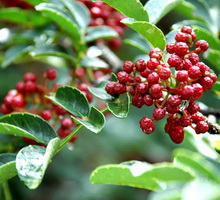 Zanthoxylum
bungeanum. 川
椒 Chuān
jiāo Bunge's
prickly ash pericarp Family: Rutaceae
Zanthoxylum
bungeanum. 川
椒 Chuān
jiāo Bunge's
prickly ash pericarp Family: Rutaceae
Native to eastern China and Taiwan. It is one of several species of Zanthoxylum from which Sichuan pepper is produced.
PART USED: The capsule pericarp or seeds
FUNCTIONS
GROUP: Warm the interior and expel Cold
1. Alleviate pain,[3] and increase appetite.
2. Disperse Dampness.[1,3]
3. Kill parasites- roundworm.[3] Vermifuge.[1]
4. Increase flow of lactation.
INDICATIONS
1. Spleen/Stomach Cold deficiency: Epigastric and abdominal Cold pain, vomiting, diarrhea and poor appetite.[1,3] Poor appetite.[3] Chills and pains in the abdomen.[1] Dysentery.[1]
2. Roundworm infection with abdominal pain or deficiency Cold condition of Spleen/Stomach.[3] Also for infestation with Enterobius vermicularis (pinworm). Ascariasis-caused abdominal pain.[1,3]
3. Moist sores on the skin.[1]
4. Galatostasis.
PREPARATIONS: The capsule pericarp or seeds are used medicinally, 2.5-4 g each dose, pulverised, then mixed with water before taking by mouth.[1]
Decoction 2-5 g; 6-15 g for lactifuge (decrease milk flow); decoction 25-30 ml for 3-4 nights successively for pinworm.[2]
NOTE*** Increasing milk flow.[2] Other sources said decreasing. It has been assumed to have the effect of increasing milk flow.
